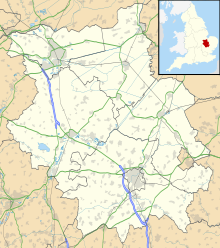Flag Fen
| Coordinates | 52°34′26″N 0°11′24″W / 52.574°N 0.190°W |
|---|---|
| Type | Archaeological open-air museum |
| Website | Flag Fen |
Flag Fen, east of Peterborough, England, is a Bronze Age site developed about 3500 years ago, comprising over 60,000 timbers, arranged in five very long rows, creating a wooden causeway (around 1 km long) across the wet fenland. Part way across the structure, a small island was formed. Items associated with it have led scholars to conclude the island was a site of religious ceremonies and significance. Archaeological work began in 1982 at the site, which is located 800 m (0.5 miles) east of Fengate. Flag Fen is now part of the Greater Fens Museum Partnership. A visitor centre has been constructed on site, and some areas have been reconstructed, including a typical Iron Age roundhouse dwelling.
A Neolithic trackway once ran across what archaeologists have termed as the "Flag Fen Basin", from a dry-land area known as Fengate, to a natural clay island called Northey (now the site of Whittlesey). The basin is an embayment of low-lying land on the western margins of the Fens. The level of inundation by 1300 BC led the occupants to construct a timber causeway along the trackway route. The causeway, and centre platform, were formed by driving 'thousands of posts with long pencil-like tips' through the 'accumulating peaty muds' and into the firmer ground below. The resulting structure covered three and a half acres.
Dendrochronological analysis, or dating of the posts by studying tree rings, led to an estimated date for the various stages of construction as between 1365 and 967 BC. Some of the timbers, such as oak, were not natural to the local environment. This means that the people who constructed this timber causeway wanted to use materials that perhaps had religious significance to their lives. They made a significant effort to transport the timbers to the site from distant sources. Similarly, scholars have traced the bluestone used at Stonehenge, Salisbury, as originating in the Preseli Mountains in Wales.
Many items denoting 'rank and prestige' were deposited in the water surrounding Flag Fen, including swords, spearheads, 'gold earrings, tiny pins and brooches'. Archaeologist Francis Pryor, who discovered the site in 1982, suggests that 'settlers often vied for social status by showing they could afford to discard valuable possessions'. There is also evidence of intentional destruction before placement, e.g., daggers broken in half placed on top of each other.
...
Wikipedia

